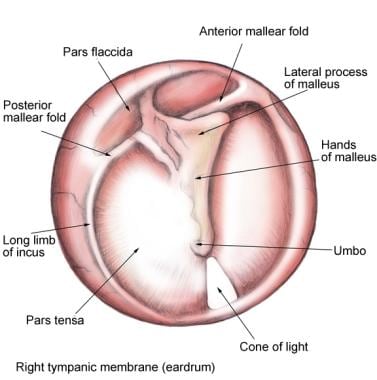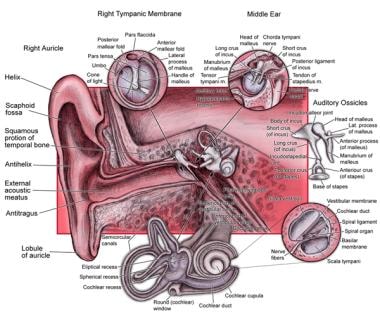Background
Myringotomy is a surgical procedure of the eardrum or tympanic membrane. The procedure is performed by making a small incision with a myringotomy knife through the layers of tympanic membrane (see the image below). This surgical procedure permits direct access to the middle ear space and allows the release of middle-ear fluid, which is the end product of otitis media with effusion (OME), whether acute or chronic. OME is classified as serous, mucoid, or purulent.
Myringotomy (radial incision).
The fluid is suctioned from the middle ear through the incision and, if indicated, sent for bacterial or viral cultures. Currently, bilateral myringotomy is often used in conjunction with placement of middle-ear ventilation tubes, which permits the incised drum to remain open and allows better drainage of middle-ear fluid.
This approach facilitates instillation of antibiotic otitic drops, and ultimately results in faster resolution of the OME.
OME may spontaneously occur as a result of inadequate ventilation of the middle-ear space related to poor eustachian tube function or a persistent inflammatory response to acute otitis media (AOM). Additional contributors to the development of OME include the immaturity both of the infant or young child’s immune system and of the anatomy of the eustachian tube.
The eustachian tube is the communication between the middle ear and the nasopharynx. Its function is to equalize pressure across the tympanic membrane. Contraction of the tensor veli palatini and the salpingopharyngeus outside of the tympanic cavity (middle ear) dilate and open the auditory tube.
In children, the eustachian tube is shorter, more horizontally oriented, and less functionally mature, and these differences can predispose children to OME. Inflammation of the mucosa of the eustachian tube orifice (from conditions such as upper respiratory infection [URI] or allergy) and improper functioning of the eustachian tube musculature lead to negative middle-ear pressure. Thus, when the eustachian tube opens, bacteria and viruses from the nasopharynx are drawn into the middle-ear space and generate an inflammatory response.
OME has a strong correlation with URI. Children with craniofacial abnormalities that affect eustachian tube function (eg, Down syndrome and cleft palate) are at increased risk for otitis media. Immune deficiency should be suspected in children with OME that occurs in association with recurrent sinusitis, bronchitis, or gastrointestinal (GI) abnormalities.
Other predisposing conditions include allergy, adenoid hypertrophy, ciliary dysfunction, and gastroesophageal reflux. OME may be seen in patients with prolonged nasal intubation or nasogastric tubes.
Relevant Anatomy
The tympanic membrane is an oval, thin, semi-transparent membrane that separates the external and middle ear (tympanic cavity). The tympanic membrane is divided into 2 parts: the pars flaccida and the pars tensa. The manubrium of the malleus is firmly attached to the medial tympanic membrane; where the manubrium draws the tympanic membrane medially, a concavity is formed. The apex of this concavity is called the umbo. The area of the tympanic membrane superior to the umbo is termed the pars flaccida; the remainder of the tympanic membrane is the pars tensa (see the image below).
Tympanic membrane (TM): pars flaccida (superior to insertion manubrium) and pars tensa (remainder of TM).
The eustachian tube is the communication between the middle ear and the nasopharynx. Its function is to equalize pressure across the tympanic membrane. Contraction of the tensor veli palatini and the salpingopharyngeus outside of the tympanic cavity (middle ear) dilate and open the auditory tube. The image below depicts middle ear anatomy.
Middle ear anatomy.
For more information about the relevant anatomy, see Ear Anatomy.



